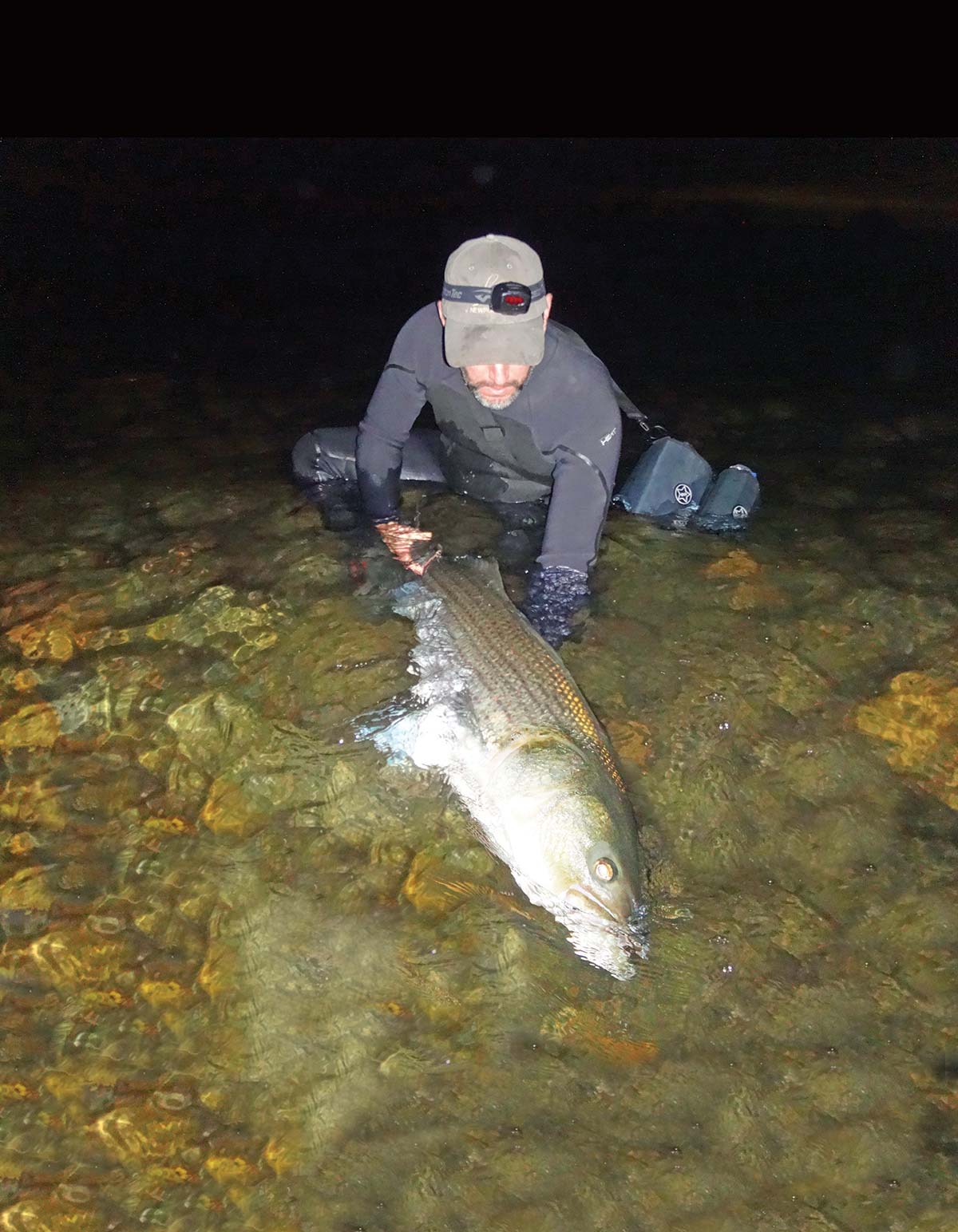
Strategies for upping your summertime striper game in the surf.
Summer surfcasting gets a bad rap. We’ve been conditioned to buy into the existence of the “summer doldrums” and to accept that summer surf fishing is difficult and largely unproductive. I wouldn’t be writing this story if I believed that, but I also can’t go forward without acknowledging that it can be a grind. But, for those of you who don’t mind grinding it out for some hard-won success, there are ways to increase your odds. Additionally, there are reasons for striped bass to come into nearshore waters that you should be thinking about when planning your summer trips.
Water Temp
There’s no disputing that striped bass are sensitive water temperature, it’s often possible to predict their arrival and departure from bays and estuaries based solely on water temperature. For example, I pay close attention to the buoy data inside Narragansett Bay in Rhode Island because I have learned that a push of large stripers leaves the bay when the water temps hit 70 degrees. Sometimes an extreme abundance of baitfish can hold them past their comfort zone, I have friends that have observed this in Raritan Bay in New Jersey, when huge numbers of bunker held stripers back past the 70-degree mark. Anomalies happen, but they are not the norm, with all other variables the same, water temperature is something that will move striped bass.
I can’t say for certain that exactly 70 degrees is always a comfort cutoff for stripers, but I can say that when stepping into the surf starts to feel like more like stepping into a freshly drawn bath, surfcasting for striped bass becomes more difficult. One important concept that I feel like not all fishermen consider is that a temperature reading does not mean that all of the water in front of you is homogenous in temperature. Think about swimming at the beach, when you swim out to that point where you’re bobbing on the surface and your shadow glides 15 or more feet below; and dive down to see if you can touch bottom, what happens? As you descend through the water column, the water gets colder and colder—until you grab that handful of sand or freak out and swim back up. This temperature gradient is something surfcasters can take advantage of.
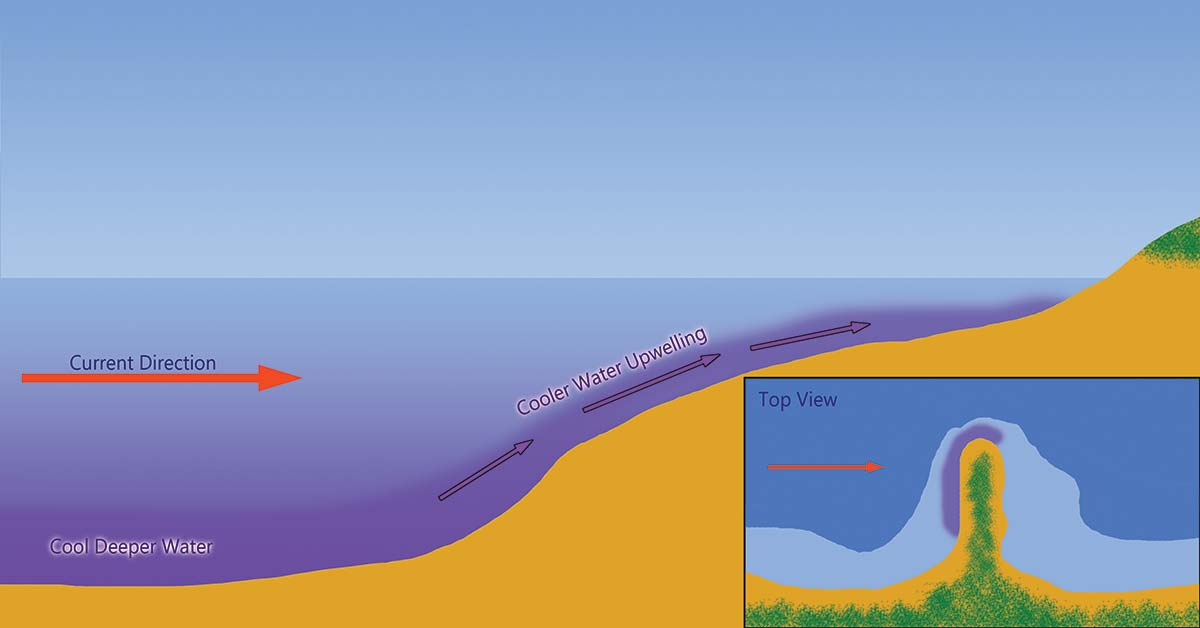
The Wedge
Tidal current is another guaranteed phenomenon can play a big role in helping you find the cooler water you’re looking for. As the tide rises and falls, it comes and goes with current that runs along the beach. This is where shoreline geography and bottom topography come into play. Start by looking for something that interrupts this current and forces it to navigate over or around an obstacle. I’m not talking about big rock or even a large jetty, I’m talking about something substantial, a point of land, an island, or even a jog in the shoreline that bends the current as flows along the shore.
To illustrate this on a micro level, I want you to think about a small river flowing through the woods, now picture what would happen if you dropped a giant rock across half of the stream. The same volume of water is going to pass through that section of the stream, but it’s going to be forced to flow around the rock and pass around it at the tip. This is a common advantage in surfcasting that is a big part of the explanation why prominent points are always good places to fish. Now think about dropping a rock into that stream that comes to rest a few inches below the surface. What happens now? The water rushes over it, forming a bit of a hump as the water rushes over and around; in essence it’s an upwelling current. Putting these two phenomena together will create the advantage you’re looking for, are you getting where I’m coming from?
Let me explain: now think about a deep body of water with a strong tide moving along the shore. Introduce a long point protruding out perpendicular to the beach to this equation, and now the water has to navigate that obstacle. All shorelines feature some kind of transitional slope leading from deep water up into the surf zone, this depth transition can act as a wedge creating lift inside the water column and bringing some of that cool water from the depths up into the shallows where it will create a bit of a temperature oasis. I also believe it may result in more oxygen in the water in that area, which is likely to attract more baitfish and foster more growth of vegetation. It’s a perfect setup for summer striped bass, especially after dark. You just have to spend a little time with a chart and put the time in to find them and figure out their timing.
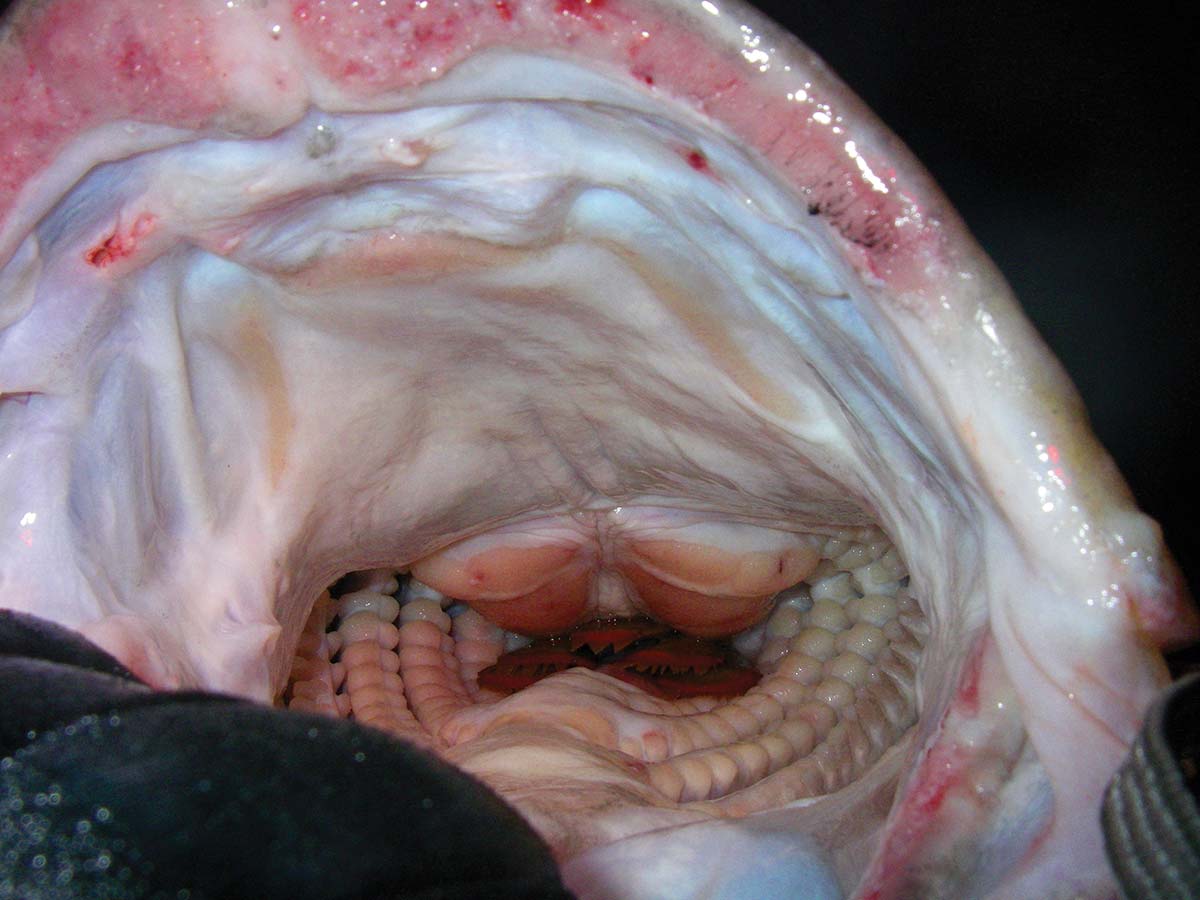
Staging Grounds
Another trick that can help you find optimum areas of focus is paying attention to where boat anglers are doing well in the summertime and making some educated guesses about where those fish might sometimes move in closer to shore for a nighttime food run. These areas exist all over the stripers’ range, some of them are more likely to bear fruit for the surfcaster than others, but fishing in places where you know fish are being caught is always a good move.
I should say, up front, that this method is not likely to reveal a spot that gives up consistent catches all summer long, but you may be able to root out a scenario that consistently draws some of those larger fish in closer to shore. Let’s use Block Island as an example here, it has been documented to death that Southwest Ledge off of Block Island harbors an eye-popping population of summer stripers, and a good percentage of these fish are absolute dinosaurs. But when you talk to surfcasters that fish the island in the summer, there are very few fish of the same trophy caliber landed from the rocks. A few hardcore guys that can put in many nights on the island over the course of a season do catch some cows, this may amount to nothing more than a test of time and a game of endurance. But I would say it’s more likely that these casters have figured out a pattern and learned how to fish it.
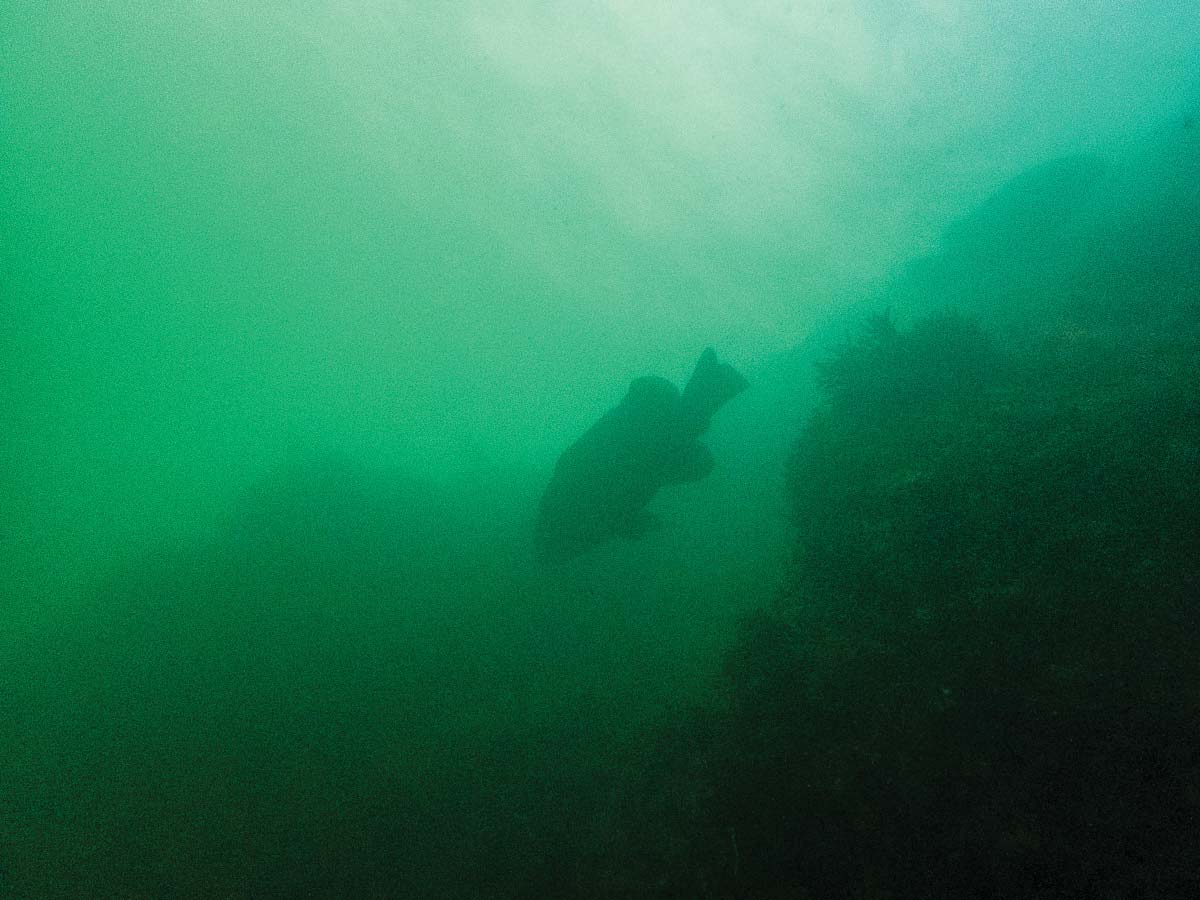
Patterning Success
There are two factors that I have seen that can result in a more consistent summer pattern in these instances, one is if there is a reliable bait source in the surf zone or in a nearby harbor or estuary. Populations of bunker are a definite draw for summertime stripers and they will make regular trips in tight to get to them—usually after dark. This is a time when chunkers tend to hook some really nice fish. Or it could be just a particularly fishy stretch of bottom that holds a strong population of, what I refer to as ‘reliable baitfish’, scup, juvenile blackfish, cunner, northern kingfish, etc. It might be a certain tide, it might only happen on the strongest currents or the darkest nights or it might require a certain wind, but there is likely a little secret to uncover that will bring some of those fish in tight.
The other is very rough surf. When these staging areas are close to shore, sometimes a kicked up surf will draw these fish in to hunt. A diver friend told me that pounding waves often drive smaller inshore bottom fish like scup and blackfish out of their hiding places, which opens them up to being targeted by opportunistic predators, and it seems like large stripers have learned to take advantage. Fishing heavy surf comes with some risks so make sure you’re equipped to deal with it, proper footwear is key, it cannot be overstated how important a set of Korkers with sharp spikes is for your comfort and safety. A quality surf top paired with a tight belt will keep you relatively dry and protect you from getting swamped. I’ve been using the Tsunami Salt-X Surf Top this year and I’m very happy with it. Or you can go the even safer route and don a wetsuit.
In big surf I tend to lean more toward straight-tail soft plastics, like Super Snax or the 8-inch ‘straight-tail’ from NLBN. I like these because they streak through the rough stuff with ease, sometimes I feel like paddletails get too wild in heavy seas. Another favorite is the Super Strike Needlefish, some situations may require the heavier red eye version—the heavy needles can be fished in a similar manner to another rough water staple; the bucktail. Of course, bottle plugs and the North Bar Bottle Darter are also standard issue for any nighttime surf situation with heavy winds and/or rough seas.
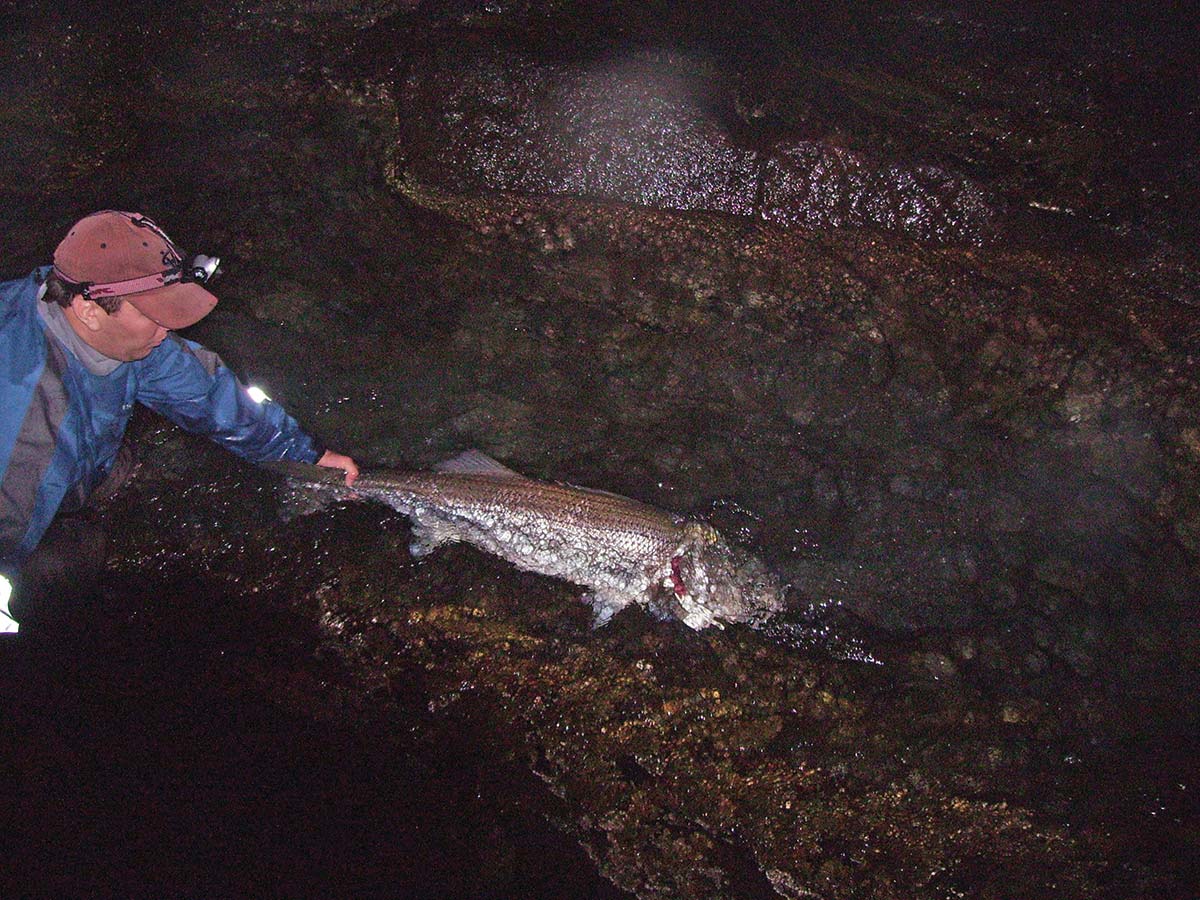
Tactical Casting
Summer surfcasting is a different game than the migrations that coincide with major bait migrations; we don’t have movements of herring, mullet and peanut bunker to fuel the inshore bite. So we have to adjust our thought processes to appeal to the feeding mode of a summer striper. I believe these fish are coming into the surf zone with one objective and that is to feed. Inshore zones harbor more reliable baitfish than what you’re likely to find out in 30-plus feet of water. If it’s rocky bottom or near prominent structure, you’re going to find more scup, blackfish, sea bass and other bottom species like lobster, if it’s sandy bottom, sand eels are likely to be prominent along with crabs and perhaps some kingfish or juvenile flounder as well. The idea is to play into what they’re programmed to want to see. Present something that acts familiar and that might just be seen as ‘too good to be true.’
One of the ways I have been able to do this is to fish with medium and deep swimming metal lips that are weighted to rise slowly when paused. I crank these down until I start ticking bottom and pause whenever I feel bottom contact. The visual is very natural, a large baitfish picking along the bottom, stopping now and then and letting the tide move them around. This can be done just as well with a paddletail plastic paired with the perfect weight jighead. When the head weight is balanced with the buoyancy and water resistance of the plastic body you can use its mass and that ‘parachute’ tail to hang the bait almost stationary for short stints of non-movement, before resuming your retrieve, the most important part of this method is to keep contact with the bait at all times.
| OFFER THEM SOME MEAT |
| If summer fishing gets especially slow don’t be too proud to pivot and throw some bait. I have often referred to the live eel as “the great equalizer”, there’s just something special about that real action, scent and feel that stripers, that won’t hit anything else, just can’t stay away from. The same can be said for fresh chunks, especially if you’re inshore hotspot is a passageway between a staging area and a place where bunker have been holding for the summer. The name of the game is catching fish, not throwing artificials. |
What I’m trying to drive home here is that I have found more summer success using subtle techniques, and if you’re fishing a pattern that only presents itself a few times per year, you want to be prepared to show them what they want to see. There are other ways to achieve these subtle presentations too, if the wave action is minimal you can get a lot done with an unweighted soft plastic. If the surf is moderate, using plastic swimmers such as a Yo-Zuri Hydro Minnow and upping the hook sizes and maybe adding a Suspend-Dot or two to dial in a very slow float will prove to be a valuable weapon during these times. And definitely do not leave the house without various weights of needlefish either, these are deadly all season long and are the subtlest plugs available to the surfcaster.
The summer doesn’t have to be a time when surfcasters turn their focus to other species, or watching their favorite MLB teams. With a few adjustments to how you choose where to fish and how you present your lures, you can enjoy great surf fishing right through the supposed doldrums. Give these tactics a try and I’m pretty sure you’re going to like the results!



